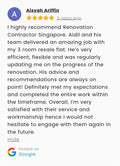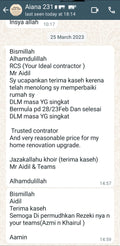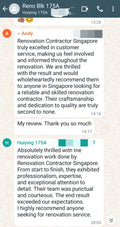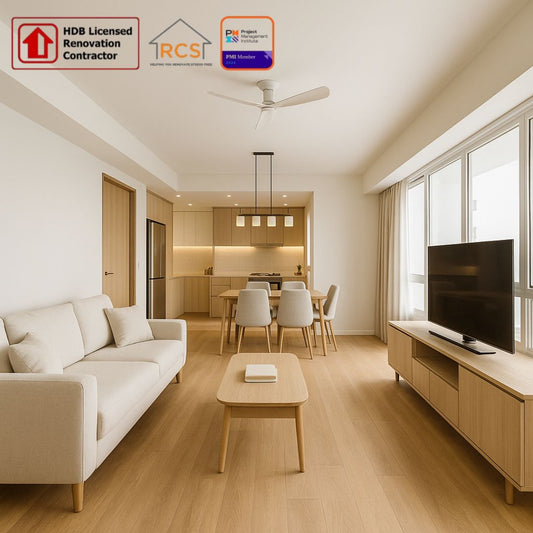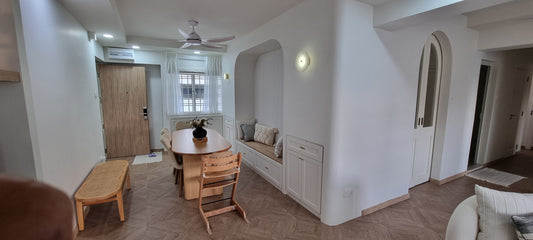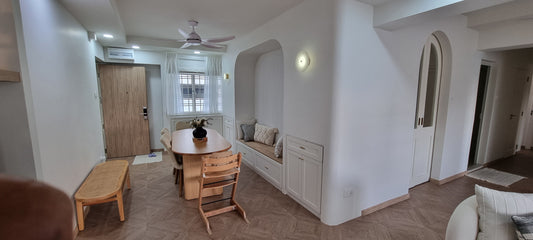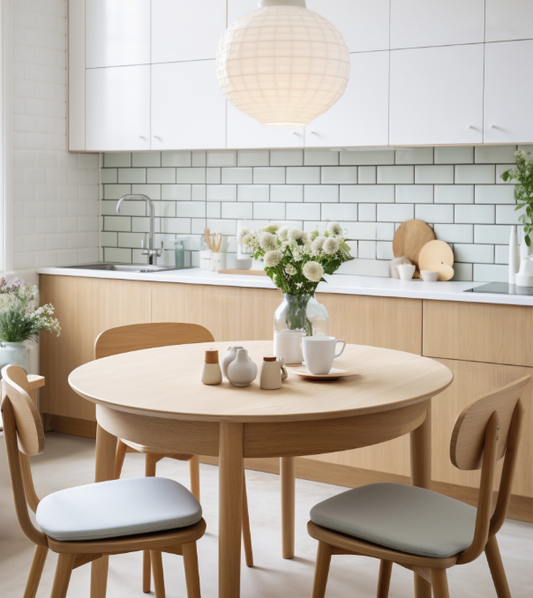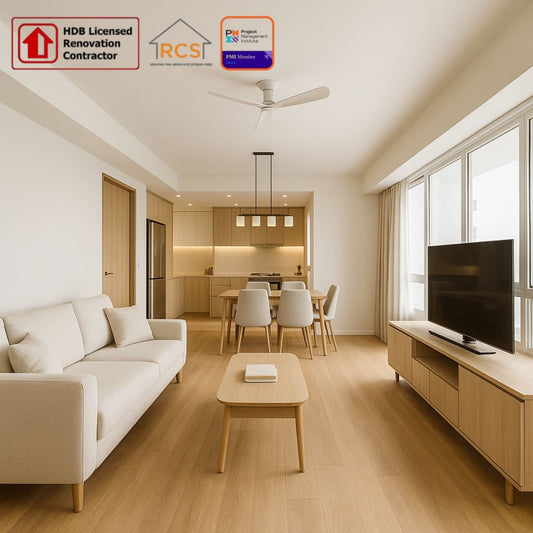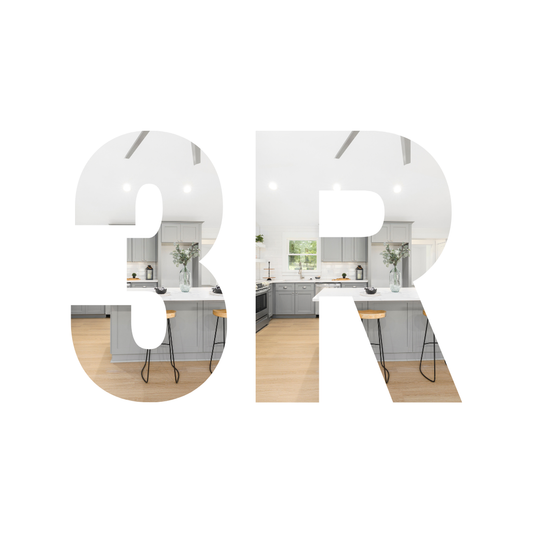Renovation costs form a significant portion of your total housing budget, often becoming the second-largest expense after the purchase price itself. Understanding the different renovation needs between BTO and resale flats can help you make smarter financial decisions.
BTO Renovation: Starting Fresh
New BTO flats come as a blank canvas with basic finishes. HDB delivers these units with:
- Concrete floors (with option for basic floor finishes through Optional Component Scheme)
- Painted walls
- Basic bathroom fittings
- Basic electrical points and lighting
- Window frames and main door
BTO renovations focus mainly on adding what you need rather than replacing existing features. Common renovation works include:
- Installing kitchen cabinets, countertops, and appliances
- Adding built-in wardrobes
- Installing additional electrical points
- Installing flooring if not chosen through OCS
- Adding shower screens
- Installing lighting fixtures
- Adding feature walls or partitions
The renovation timeline for BTO flats typically runs shorter, averaging 8-10 weeks for 3-room and 4-room units, since there's minimal hacking or demolition required. If you're looking for cost-effective solutions, consider exploring 3-room BTO renovation packages, 4-room BTO renovation packages, or 5-room BTO renovation packages that bundle essential works at competitive prices.
Resale Renovation: Dealing With History
Resale flats often require more extensive work, especially older units. These renovations typically involve both removing old elements and installing new ones:
- Hacking and demolition of existing tiles, built-in cabinets, or non-structural walls
- Rewiring of electrical systems (crucial for flats over 30 years old)
- Replacing plumbing pipes (older galvanized iron pipes often need replacement)
- Waterproofing bathrooms after hacking
- Making sound walls and floors after demolition
- Installing all new finishes and fittings
The additional demolition and infrastructure work extends the timeline to 10-12 weeks or longer, depending on the flat's age and condition. For resale units, specialized 3-room resale renovation packages, 4-room resale renovation packages, and 5-room resale renovation packages can help manage costs while addressing the unique challenges of older flats.
Cost Comparison Table: BTO vs Resale Renovation (2025)
| Renovation Component | BTO Cost Range | Resale Cost Range | Notes |
|---|---|---|---|
| Demolition/Hacking | $0-$1,000 | $5,000-$8,000 | Older resale flats often require extensive hacking |
| Electrical Works | $2,000-$4,000 | $5,000-$15,000 | Full rewiring needed for older resale flats |
| Plumbing | $1,000-$2,000 | $2,500-$6,300 | Replacement of aged pipes in resale units |
| Flooring | $6,000-$12,000 | $7,000-$15,000 | Resale costs higher due to hacking existing floors |
| Kitchen | $8,000-$15,000 | $10,000-$20,000 | Resale often requires demolition first |
| Bathrooms | $5,000-$10,000 | $8,000-$16,000 | Waterproofing needed after hacking in resale |
| Carpentry (Wardrobes) | $5,000-$12,000 | $5,000-$12,000 | Similar for both types |
| Painting | $2,000-$3,500 | $2,500-$4,000 | Larger area in 5-room flats |
| Total (4-Room Flat) | $30,000-$60,000 | $50,000-$100,000+ | Resale costs 20-40% higher on average |
The condition of a resale flat significantly impacts renovation costs. A 5-year-old flat might need mostly cosmetic updates, while a 40-year-old unit could require complete gutting and infrastructure replacement. Always set aside a 10-15% contingency fund, especially for older resale flats where hidden issues like deteriorated wiring or compromised waterproofing might only become apparent during renovation.
Legal and Compliance Requirements for Buying HDB Flats in 2025
The HDB purchase process involves several legal and compliance requirements, with resale transactions having additional steps compared to BTO applications.
HDB Flat Eligibility (HFE) Letter
As of 2025, all prospective HDB buyers must first obtain an HDB Flat Eligibility (HFE) letter before proceeding with their purchase:
- Purpose: Confirms eligibility to purchase, assesses grant qualification, and verifies HDB loan eligibility
- Application: Via the HDB Flat Portal using Singpass
- Timing: Apply early, as processing can take several weeks, especially before major BTO launches
This upfront eligibility check prevents situations where buyers might pay option fees only to discover they're ineligible later.
Resale-Specific Legal Requirements
The resale process includes several unique legal steps:
1. Option to Purchase (OTP) Process
- Seller must register Intent to Sell at least 7 days before granting OTP
- Buyer pays Option Fee ($1-$1,000) to secure the flat
- OTP valid for 21 calendar days
- Exercise within this period by paying the Option Exercise Fee (total deposit capped at $5,000)
2. Request for Value
- Mandatory if using CPF or taking a housing loan
- Must be submitted by the next working day after OTP date
- Costs $120 and requires a scanned copy of the OTP's first page
- Valuation outcome typically available within 10 working days
- Crucial for determining Cash-Over-Valuation (COV) amounts
3. Ethnic Integration Policy (EIP) & SPR Quota Checks
A unique aspect of Singapore's public housing, these quotas ensure ethnic diversity in HDB estates:
- EIP sets limits for different ethnic groups at both block and neighborhood levels
- SPR quota limits non-Malaysian permanent resident households to 8% per block and 5% per neighborhood
- Quota eligibility must be met at multiple stages: OTP grant, OTP exercise, and resale application submission
- Monthly updates to quotas (1st of each month) can affect transaction eligibility
4. Lease-Related Legal Implications
The remaining lease significantly impacts legal and financial aspects:
- CPF Usage: The flat's remaining lease must cover the youngest buyer until age 95 for full CPF usage; otherwise, usage is pro-rated
- HDB Loan: Loan tenure is capped at the remaining lease minus 20 years
- Bank Loans: Most banks have minimum remaining lease requirements (typically 30-35 years)
Common Compliance Mistakes
- Failing to check EIP/SPR quotas before paying the Option Fee: This risks losing the fee if the transaction can't proceed due to quota restrictions.
- Not obtaining the HFE letter early enough: This delays the entire purchase process, potentially losing desired units.
- Exercising the OTP before receiving the valuation outcome: This commits buyers to a purchase price without knowing if there's a Cash-Over-Valuation requirement.
- Overlooking lease-related financing restrictions: Many buyers discover too late that shorter leases severely limit loan amounts.
- Missing the 3-month validity period for valuations: If the resale application isn't submitted within this window, a new valuation is required.
For a smooth transaction, work with HDB-registered property agents familiar with the latest requirements and use the HDB Flat Portal to track application progress.
Busting the Top 5 HDB Buying Myths
The HDB market is filled with common misconceptions that can lead to poor decision-making. Let's separate fact from fiction with these top five myths:
Myth #1: "BTO flats are always much cheaper than resale"
The Reality:
- While BTO base prices are lower, eligible resale buyers can access substantially higher grants
- First-timer resale buyers can receive up to $230,000 in grants (EHG + Family Grant + PHG) versus $120,000 (EHG only) for BTO
- When accounting for renovation costs, waiting time expenses, and grants, the net cost difference can be surprisingly small
- For some eligible buyers, the final cost of a resale flat may actually be lower than a comparable BTO after factoring in all grants
Myth #2: "Older resale flats have no investment value due to lease decay"
The Reality:
- Despite lease decay, older flats in prime locations have shown positive returns over time
- Location, amenities, and flat attributes remain strong value drivers
- Recent market data from 2023-2025 shows price appreciation even for flats with 50-60 years remaining lease
- Government upgrading programs like HIP and NRP help maintain older estates' value
- VERS (Voluntary Early Redevelopment Scheme) aims to provide a value recovery pathway for aging flats
Myth #3: "BTO waiting times are still too long after COVID-19"
The Reality:
- HDB has cleared all 92 pandemic-delayed projects as of early 2025
- Median waiting time for 2024-2025 BTO projects has returned to pre-pandemic levels (less than 4 years)
- Shorter Waiting Time (SWT) flats with waiting periods under 3 years now make up nearly 20% of BTO supply
- Sale of Balance Flats (SBF) offers options that are already under construction or completed
- The February 2025 BTO launch included projects in Yishun with waiting times of just 37-38 months
Myth #4: "The resale process is much more complicated than BTO application"
The Reality:
- Both processes have been streamlined through the HDB Flat Portal
- The HFE letter requirement now standardizes the initial eligibility check for both BTO and resale
- Resale does involve additional steps (valuation, OTP, EIP checks) but most can be completed online
- The entire resale process typically takes 3-4 months from search to key collection
- HDB provides clear timelines and notifications throughout the resale application process
Myth #5: "Prime/Plus BTO restrictions make them poor investments"
The Reality:
- Plus/Prime restrictions are designed features, not bugs, serving specific policy objectives
- These flats offer significantly subsidized entry into prime locations
- The 10-year MOP and restrictions target buyers seeking long-term homes, not short-term investors
- They deliver high living value through prime locations and amenities
- For buyers planning to stay long-term, the restrictions have minimal practical impact
Understanding these realities helps you make more informed decisions based on your specific circumstances rather than market generalizations.
Pro Tips for First-Time HDB Buyers in 2025
Navigating Singapore's unique housing market requires strategic thinking. Here are five expert-level tips for first-time buyers deciding between BTO and resale in 2025:
Tip #1: Strategize around the 2025 MOP supply anomaly
The number of flats reaching MOP in 2025 is at its lowest in over a decade (around 7,000 units), creating a supply constraint in the resale market. This presents both challenges and opportunities:
- Resale prices for newer flats (especially recently MOP-ed units) may command premiums due to limited supply
- Consider BTO if not in urgent need as the MOP supply increases significantly in 2026 (13,500 units) and 2028 (19,500 units)
- If targeting a resale flat, widen your search parameters or consider slightly older units to avoid the fierce competition for newly MOP-ed flats
Tip #2: Leverage the new Standard/Plus/Prime framework strategically
The recent classification system offers nuanced choices beyond the traditional BTO vs. resale dichotomy:
- Standard BTOs provide the most flexibility with a 5-year MOP and no special restrictions
- Plus/Prime BTOs offer access to prime locations with higher subsidies but 10-year MOPs and restrictions
- Consider a Standard BTO in a non-mature estate if investment flexibility matters most
- Consider Plus/Prime BTO only if you value location over future flexibility and plan to stay long-term
- Resale remains the best option for immediate housing needs or specific location requirements
Tip #3: Time your purchase around SBF exercises for better value
Sale of Balance Flats (SBF) exercises offer a middle ground between BTO and resale:
- The February 2025 SBF exercise was the largest ever with over 5,500 units
- About 40% of SBF flats were already completed, offering almost immediate occupancy
- Another SBF exercise is planned for July 2025 with around 3,000 units
- SBF flats typically have shorter waiting times but retain BTO pricing advantages
- Application rates for SBF can be lower than popular BTO projects, potentially improving ballot chances
Tip #4: Calculate the true "lease-adjusted cost per year"
When comparing flats with different remaining leases, calculate the annual cost of ownership for more accurate comparison:
- Divide the total cost (purchase price + renovation - expected resale value) by the number of years you plan to live there
- This approach properly accounts for lease decay when comparing a newer but expensive flat versus an older but cheaper one
- Example: A $600,000 flat with 70 years lease might actually be cheaper per year of ownership than a $450,000 flat with 45 years lease, depending on your planned stay duration
Tip #5: Budget for rising renovation costs and construction material inflation
Renovation costs have been particularly volatile in 2024-2025:
- Set aside 10-15% more than typical renovation budget estimates, especially for resale
- For older resale flats (>30 years), budget for essential infrastructure upgrades (rewiring, plumbing)
- Consider phasing renovations to spread costs if purchasing a resale flat that's habitable as-is
- For BTO, take advantage of the OCS (Optional Component Scheme) for basic finishes, which may be more cost-effective than engaging contractors separately
- Get multiple quotations and verify contractor credentials through HDB's Directory of Renovation Contractors
Remember that the "best" choice between BTO and resale depends on your specific circumstances—financial situation, urgency for housing, location preferences, and long-term plans. Use these tips to make a decision that aligns with your unique needs in Singapore's evolving housing market.





